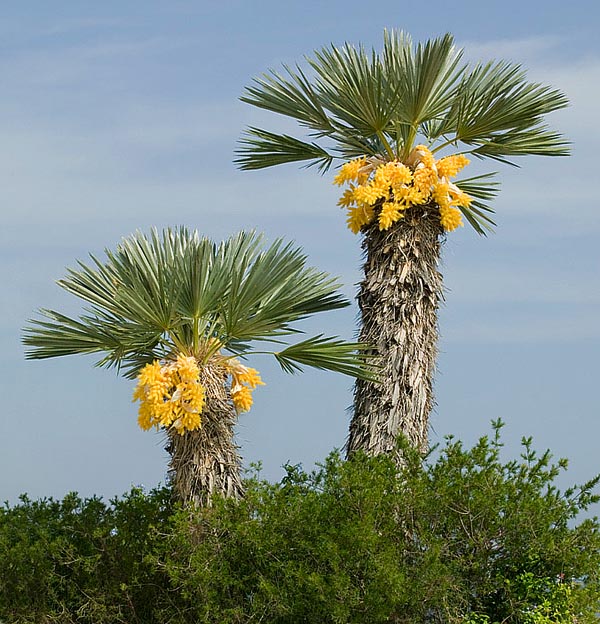Family : Arecaceae

Text © Pietro Puccio

English translation by Mario Beltramini

Native to Argentina, Trithrinax campestris stands the heat but also -12 °C © Giuseppe Mazza
The name of the species comes from the Latin “campestris” = “of broad field”.
The Trithrinax campestris (Burmeist.) Drude & Griseb. (1879) is widespread in Argentina, where it grows up in the bottom of valleys or in open and arid locations characterized by a long and dry season, and, marginally, in Uruguay.
The fibres extracted from the leaves are locally utilized for handicrafts.
It is called “saro” in Argentina, and “caranday” in Uruguay, whilst in the English-speaking countries, it is usually known as “blue needle palm”, “spiny fiber palm”, or “caranday palm”.
Common names: “blue needle palm”, “campestre palm”, “caranday palm”, “spiny fiber palm”, “thatch palm” (English); “palmier trident”, “trithrinax d’Argentine” (French); “caranday”, “palmera de Argentina”, “palmera del Uruguay”, “saro” (Spanish); “blaue nadelpalme” (Dutch).
Single trunk or cespitose palm, with trunks which can reach the height of 6 metres, with a diameter of about 25 cm, covered by a thick knot of fibres which have the consistency of real and proper thorns turned downwards. The leaves, on unarmed petioles, are palmate, wide about 50 cm, of bluish grey colour and extremely rigid, with bifid, and sharp as thorns, segments. The dried up leaves remain for long time adherent to the trunk, covering it, at times, up to the base. The short inflorescences, very ramified and showy, are of a yellowish colour. The flowers, hermaphrodite, are followed by globular, yellowish fruits, of 1,5 cm of diameter. The seeds do germinate in 100-120 days.

It can be 6 m tall with its stem covered by thorny fibres. Very ornamental, short and ramified luminous inflorescences © Giuseppe Mazza
Synonyms: Copernicia campestris Burmeist. (1861); Chamaethrinax hookeriana H.Wendl. ex R.Pfister (1891).
→ For general notions about ARECACEAE please click here.
